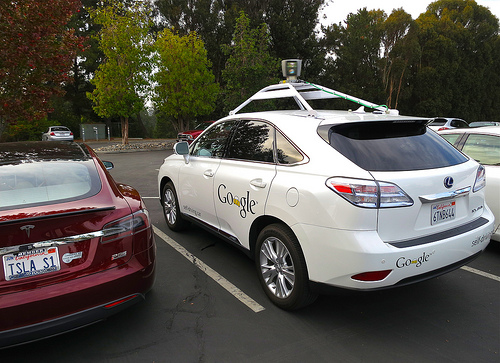Self-driving cars don’t just merely make drivers’ lives easier — they may also save cyclists’ lives. Robot-driven cars don’t make the dangerous, poor and potentially fatal choices human drivers do, reports FastCompany. Plus, a self-driving car won’t develop road rage, either — an important and even life-saving benefit for the cyclist recipients of driverly anger.

FastCompany predicts that self-driving cars will improve cyclist safety. From Steve Jurvetson.
Chris Urmson, Director of the Self-Driving Car Project at Google, writes about the tech updates on a Google blog: “We’ve improved our software so it can detect hundreds of distinct objects simultaneously–pedestrians, buses, a stop sign held up by a crossing guard, or a cyclist making gestures that indicate a possible turn. A self-driving vehicle can pay attention to all of these things in a way that a human physically can’t–and it never gets tired or distracted.”
Self-driving cars also do not become frustrated. In a video which you can view here (scroll down), the self-driving car encounters a cyclist on the side of the street, detects the biker’s left-hand turn signal, and slows down to allow the biker to bike into the car’s lane. The biker bikes back onto the roadside, then uses a hand signal to return into the car’s lane; the self-driving car yields to the cyclist. Further on in the journey, the car senses bikers approaching from behind, and waits before making a turn to prevent hitting the cyclists.
The Google Self-Driving Car Project has clocked thousands of miles on the streets of Mountain View, California. Given that, as Urmson writers, “A mile of city driving is much more complex than a mile of freeway driving, with hundreds of different objects moving according to different rules of the road in a small area,” software needed to be improved accordingly. The newest update has resulted in software that “can detect hundreds of distinct objects simultaneously—pedestrians, buses, a stop sign held up by a crossing guard, or a cyclist making gestures that indicate a possible turn.”
Self-driving cars first became legal in Nevada in 2011, and today they are also legal in California, Michigan and Florida. Since that time, as CNN reports, Google has run up almost 700,000 miles — most of those clocked on highways — with the only reported accidents occurring when one of the cars was driven by a human, or due to the fault of another driver.
Self-driving cars use such technology as a laser radar system as well as a laser-based range finder, which allows software to develop 3-D maps of the car’s surroundings. Admittedly, the obstacles on the streets of Mountain View pale in comparison to those found in the crowded intersections of, say, Manhattan or Chicago. But progress is progress.
As Urmson writes, “We still have lots of problems to solve, including teaching the car to drive more streets in Mountain View before we tackle another town, but thousands of situations on city streets that would have stumped us two years ago can now be navigated autonomously.”